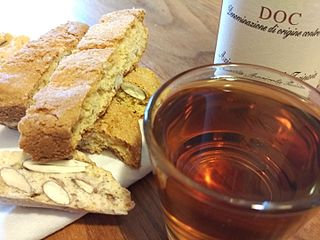 W
WBrunello di Montalcino is a red DOCG Italian wine produced in the vineyards surrounding the town of Montalcino, in the province of Siena, located about 80 km south of Florence in the Tuscany wine region. Brunello, a diminutive of Bruno ("brown"), is the name that was given locally to what was believed to be an individual grape variety grown in Montalcino. In 1879 the Province of Siena's Amphelographic Commission determined, after a few years of controlled experiments, that Sangiovese and Brunello were the same grape variety, and that the former should be its designated name. In Montalcino the name Brunello evolved into the designation of the wine produced with 100% Sangiovese.
 W
WCarmignano is an Italian wine region located in the Tuscany region and centered on the city of Carmignano, about 10 miles northwest of Florence. Noted for the quality of its wines since the Middle Ages, Carmignano was identified by Cosimo III de' Medici, Grand Duke of Tuscany as one of the superior wine producing areas of Tuscany and granted special legal protections in 1716. In the 1800s, the producers of the Carmignano region developed a tradition of blending Sangiovese with Cabernet Sauvignon, long before the practice became popularized by the "Super Tuscan" of the late 20th century. In 1975, the region was awarded Denominazione di origine controllata (DOC) status and subsequently promoted to Denominazione di Origine Controllata e Garantita (DOCG) status in 1990 (retroactive to the 1988 vintage. Today Carmignano has approximately 270 acres planted, producing nearly 71,500 gallons of DOCG designated wine a year.
 W
WA Chianti wine is any wine produced in the Chianti region of central Tuscany. It was historically associated with a squat bottle enclosed in a straw basket, called a fiasco. However, the fiasco is only used by a few makers of the wine as most Chianti is now bottled in more standard shaped wine bottles. Baron Bettino Ricasoli created the Chianti recipe of 70% Sangiovese, 15% Canaiolo and 15% Malvasia bianca in the middle of the 19th century.
 W
WColli di Luni is an Italian Denominazione di origine controllata (DOC) located in both Liguria and Tuscany in northwest Italy. The DOC produces both reds and white wines made primarily from Sangiovese and Vermentino with a varietal Vermentino also being produced in the DOC.
 W
WMorellino di Scansano DOCG is an Italian red wine made in the hilly environs of the village of Scansano, GR, in the Maremma region of coastal Tuscany, which has an ancient but obscure tradition of winemaking. Morellino is the local name for the Sangiovese grape variety. Many people think that the name Morellino comes from morello (brown), the colour of the region's horses. The name may also come from the morello cherry, a dark red cherry with great tartness and acidity. The wine, which was granted DOC status in 1978, then upgraded to DOCG status beginning with the 2007 vintage, is made from at least 85% Sangiovese, which is also the basis of the Tuscan wines Chianti, Brunello di Montalcino, and Vino Nobile di Montepulciano. The remaining 15% can comprise any non-aromatic black grape varieties included in a list made and periodically updated by Tuscan wine authorities.
 W
WVernaccia is a white Italian wine, made from the Vernaccia grape, produced in and around the Italian hill town of San Gimignano in Tuscany. Since the Renaissance, it has been considered one of Italy's finest white wines. It was the first Italian wine to be awarded Denominazione di Origine Controllata (DOC) status in 1966; on July 9th, 1993 it was upgraded to Denominazione di Origine Controllata e Garantita (DOCG).
 W
WVin Santo [vin ˈsanto] is a style of Italian dessert wine. Traditional in Tuscany, these wines are often made from white grape varieties such as Trebbiano and Malvasia, though Sangiovese may be used to produce a rosé style known as "Occhio di Pernice" or eye of the partridge. The wines may also be described as straw wines since they are often produced by drying the freshly harvested grapes on straw mats in a warm and well ventilated area of the house. Though technically a dessert wine, a Vin Santo can vary in sweetness levels from bone dry to extremely sweet. While the style is believed to have originated in Tuscany, examples of Vin Santo can be found throughout Italy and it is an authorised style of wine for several Denominazione di origine controllata (DOCs) and Indicazione geografica tipica (IGTs).
 W
WVino Nobile di Montepulciano is a red wine with a Denominazione di Origine Controllata e Garantita status produced in the vineyards surrounding the town of Montepulciano, Italy. The wine is made primarily from the Sangiovese grape varietal, blended with Canaiolo Nero (10%–20%) and small amounts of other local varieties such as Mammolo. The wine is aged for 2 years ; three years if it is a riserva. The wine should not be confused with Montepulciano d'Abruzzo, a red wine made from the Montepulciano grape in the Abruzzo region of east-central Italy.